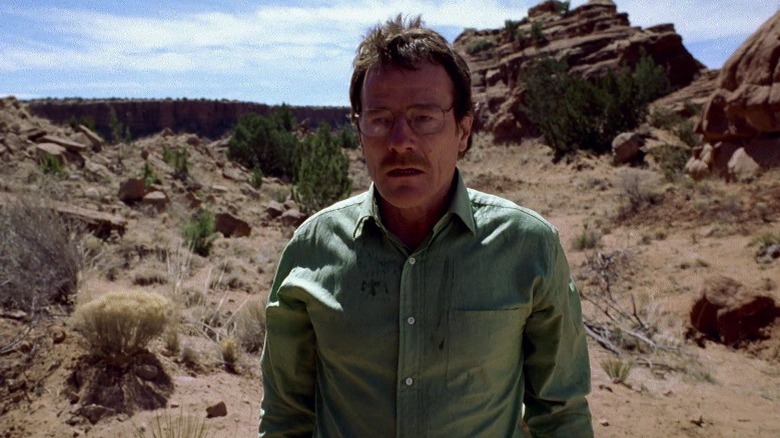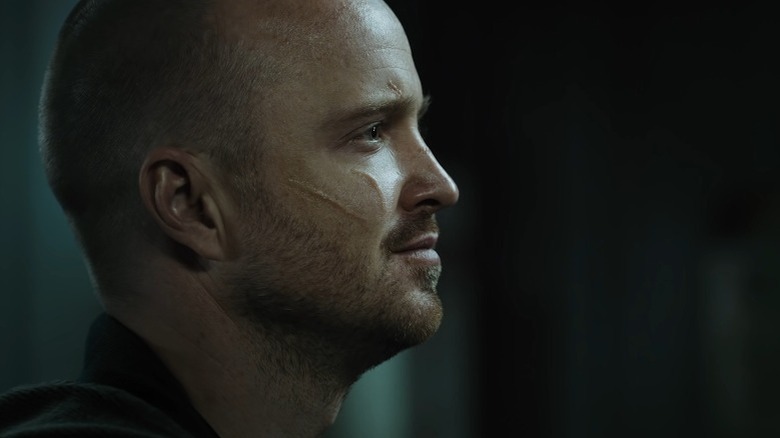How To Watch The Breaking Bad Franchise In Order (And How To Mix It Up)
The idea of the period spanning from the late 2000s until today as a "Peak TV" age is so disseminated in culture, criticism, and even the fabric of TV production itself that we almost take it for granted nowadays. But there are still the ones that stand out even from that saturated crop as era-defining titles — including the ones that spurred Peak TV into being in the first place. Given the inarguable degree to which "Breaking Bad" is one such show, it's rather fitting that it has become a franchise covering almost the entirety of that gilded period.
Beginning with the original AMC series about a high school chemistry teacher (Bryan Cranston) who starts producing and selling methamphetamine to pay for his cancer treatment and gradually builds himself up as a criminal kingpin, and on through the legal spin-off "Better Call Saul," the Netflix sequel film "El Camino," and various other side and bonus projects, the Vince Gilligan-created "Breaking Bad" universe has only become wider and more sprawling in the decade since "Breaking Bad" itself concluded. This now leaves prospective first-time viewers with the question of how to start diving into the universe in question. For the benefit of those viewers, here is the most "correct" order in which to watch the entire "Breaking Bad" franchise — as well as a few different, less orthodox options.
The release order is the way to go for first-timers
Given the enormity of "Breaking Bad" and its impact, legacy, and cultural presence, watching it is as much an exercise in participation as an experience in storytelling. As incredible as the series is in itself, sharing it with the world makes it even better. And the Gilliverse franchise became keenly aware of that as it went along, reacting and responding to the world's own response to "Breaking Bad," playing with audience expectations, dosing fanservice and in-jokes (this is, after all, an often deeply funny franchise), and offering subtle, retrospective commentary on itself. In light of all that, the best way for a first-timer to experience the franchise is in the order that the entire world did.
A release-order viewing of "Breaking Bad" would start, of course, with "Breaking Bad" itself, which ran for five seasons, one of them split into two halves, between 2008 and 2013. Follow up "Breaking Bad" with the first four seasons of "Better Call Saul," a prequel series following the backstory of recurring "Breaking Bad" character Saul Goodman a.k.a. Jimmy McGill (Bob Odenkirk); "Better Call Saul" began in 2015, and Season 4 concluded in October 2018. Before continuing "Better Call Saul," go ahead and watch the Jesse Pinkman (Aaron Paul)-focused sequel film "El Camino," released in 2019, just prior to Season 5 of "Better Call Saul." Then, finish off the cycle with the last two seasons of the spin-off show — likely, per Vince Gilligan, to be the franchise's endpoint.
A more thorough release-order viewing can include the web series and webisodes
If you want to make your release-order viewing of the "Breaking Bad" franchise even more thorough, you can also incorporate two parallel web series into it — namely, "Breaking Bad: Original Minisodes," and "Better Call Saul Employee Training." Although narratively extraneous and not essential to the enjoyment of the shows themselves, both of these comedic series are a lot of fun and can be watched quickly in between seasons.
If you want to give them a watch, start with the first batch of "Original Minisodes" between your viewing of Seasons 1 and 2 of "Breaking Bad." Then watch the second batch — which is focused on Saul Goodman and doubles as a tease of what you'll get on "Better Call Saul" — between Seasons 2 and 3, and the remaining two minisodes between Seasons 3 and 4.
"Employee Training," meanwhile, is actually a grouping of four separate web series made up of in-universe training videos, each pertaining to the context of a different season of "Better Call Saul" and released as an appendage to it, in what became a kind of tradition for the show. Those series were released weekly alongside the "main" "Better Call Saul" episodes and can be watched as bonuses after each episode. Watch "Los Pollos Hermanos Employee Training" during Season 3, "Electromotive Security Training with Mike Ehrmantraut" during Season 4, "Ethics Training with Kim Wexler" during Season 5, and "Filmmaker Training" during Part 2 of Season 6.
If you want to watch everything, include the shorts as well
The "bonus content" in the "Breaking Bad" franchise doesn't stop at the web series. If you develop an interest in watching everything a diehard fan had access to in the Gilliverse, there are also a handful of short films released in tandem with the three principal projects. The first one would be "Chicks 'N' Guns," a short released in 2013 as part of the "Breaking Bad" Season 5 home media bonus features, which offers additional context on the midseason finale episode "Gliding Over All." Watch it right after you're done with "Breaking Bad."
Later on, when you've finished Season 3 of "Better Call Saul," treat yourself to "No Picnic," a three-minute, "where are they now"-style short film focused on Season 1 characters Betsy (Julie Ann Emery) and Craig Kettleman (Jeremy Shamos).
After you watch "El Camino: A Breaking Bad Movie," you can watch the other self-contained film released simultaneously with it: "Snow Globe: A Breaking Bad Short," focused on the character of Todd Alquist (Jesse Plemons). This takes place in the lead-up to the film's events.
Finally, there's "American Greed: James McGill," a 10-minute mockumentary that, as its title suggests, recaps the trajectories of Jimmy McGill and Kim Wexler (Rhea Seehorn) in the style of an episode of the CNBC series "American Greed," complete with talking head interviews with various "Better Call Saul" characters. It serves as a perfect refresher and summary to watch before starting Season 6.
The in-unverse chronological order can be an interesting way to mix things up
Even though the "Breaking Bad" franchise can be best enjoyed as a complete work if you watch it in the order in which it was originally put out into the world, there is a certain degree of separation between its components. Vince Gilligan himself told Rolling Stone that "Breaking Bad," "Better Call Saul," and "El Camino" are each self-contained works that can be seen independently from each other. Which, of course, leaves open the possibility of changing up the viewing order. If you're looking to have a different experience with the franchise, there's always the option to watch it all in the in-universe chronological order, which renders the whole thing an epic, linear, multi-character saga.
Being a prequel, "Better Call Saul" naturally depicts events that take place prior to anything else on the show chronologically. In fact, it can, for the most part, be watched without any prior knowledge of the "Breaking Bad" universe. That said, it does dovetail with the "Breaking Bad" timeline in its last four episodes, following a time jump on the ninth episode of Season 6. Therefore, a chronological viewing of the franchise would comprise the first five seasons of "Better Call Saul," than Season 6 up until Episode 9, titled "Fun and Games," then all of "Breaking Bad," then "El Camino," and then the final four "BCS" episodes, which act as a chronologically freewheeling coda to the whole Gilliverse.
There are other possible viewing orders as well
In addition to the release order and the internal chronological order, there are several other ways in which you can watch the "Breaking Bad" franchise to get a different experience. One way favored by many fans now, and which wasn't available to those who watched everything in the franchise as it came out, is to watch "Breaking Bad" in full, then watch "El Camino" while the original show's context and hard-hitting ending are still fresh in the mind, and only then hop on over to "Better Call Saul."
Some fans of the Gilliverse also swear by the benefits of watching "Breaking Bad" and "Better Call Saul" at the same time, as though they were entirely separate series airing on different days of the week, or interpolating seasons, with "El Camino" as an epilogue to "Breaking Bad," and "Better Call Saul" Season 6 as the grand conclusion of the entire thing. It's a method that has been favored by prospective viewers who think "Better Call Saul" seems more up their alley and don't want to wait so long to get to it, and, while highly unorthodox, it can be more-or-less functional — provided that Season 6 of "Better Call Saul" is saved for last, since the show is its own beast up to that point, but becomes a rather direct and spoiler-laden response to "Breaking Bad" in its final year; its last four episodes straight-up don't make sense if you haven't seen "Breaking Bad."





